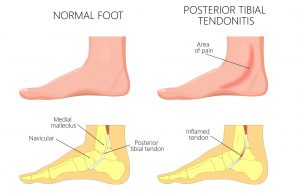
Sharp pains in your arch or inner ankle? Popping sensations? Sore to the touch? These are all signs you might have posterior tibial tendonitis!
Posterior tibial tendonitis is a common runner’s injury that can stop you in your tracks and make you wonder if you will ever run pain free again. Never fear though we can help you can back on track, literally!
Causes and Symptoms
The posterior tibial tendon is one of the most important tendons of the leg. This tendon attaches the calf muscle to the bones of the inside foot. The main function is to hold up the arch and support the foot while walking. An acute injury like a fall can tear the tendon or cause it to become inflamed. Once the tendon becomes damaged the arch will slowly fall over time. This can cause pain along the inside of the foot or ankle, pain that worsens with activity, and pain on the outside of the ankle due to compensation.
Home Treatment
- Resting your foot as much as possible with it elevated to reduce pressure to the arch is a good strategy
- Staying off your foot as much as possible and switching to swimming or bicycling to reduce foot pressure is also a good strategy
- Icing your foot – you can use a freezer gel pack, or use a plastic bag with some ice wrapped in a cloth. Place it on your foot around your arch. You may need to use medical tape or tie a cloth around the ice pack to keep it in position on the foot
- Anti-inflammatory medications – this includes a topical analgesic gel or Motrin, Advil or Aleve by mouth to bring down the swelling and reduce pain
- Once pain allows, do calf stretching and perform strengthening exercises for the tendon, such as a seated theraband with light resistance type exercise
Download a Free Copy of our Posterior Tibial Tendonitis Stretching and Exercise Guide
Home treatment isn’t working? We have several in office ways to help you
In Office Diagnosis:
I will do a physical examination to look for several signs of this conditions such as swelling, a change in the shape of the foot, toe layout, flexibility and range of motion. X-ray, ultrasound, MRI and CT scans may also be used to further evaluate the tendon and rule out a posterior tibial tendon tear.
In Office Treatment
- Physical therapy is something I can write a prescription for if home stretches are not enough. Physical therapists offer rehabilitation exercises or other modalities to help the foot to heal
- I can also give steroid injections or prescribe stronger anti-inflammatory medication
- Podiatry recommended orthotics – insoles for posterior tibial tendon problems should support the medial longitudinal arch
- I may prescribe bracing or a CAM boot to keep the foot immobilized. A lace-up ankle brace may help mild to moderate flatfoot by supporting the joints of the back of the foot and take tension off of the tendon. A custom-molded leather brace is needed in severe flat foot that is stiff or arthritic. The brace can help some patients avoid surgery
- Additional treatment options including surgery may even be discussed
When can I return to running?
 Posterior Tibial Tendonitis can cause permanent damage if not properly taken care of, so returning to running should be very gradual. If you think you may be experiencing symptoms of posterior tibial tendonitis, please schedule an appointment for evaluation.
Posterior Tibial Tendonitis can cause permanent damage if not properly taken care of, so returning to running should be very gradual. If you think you may be experiencing symptoms of posterior tibial tendonitis, please schedule an appointment for evaluation.